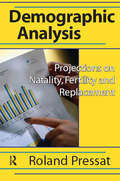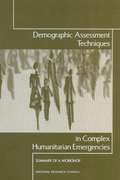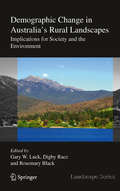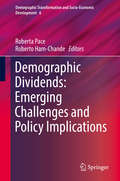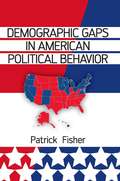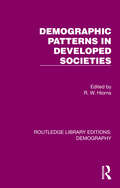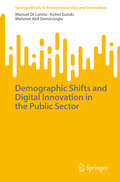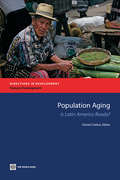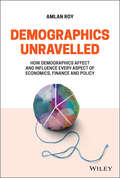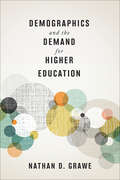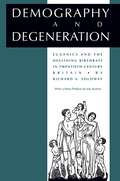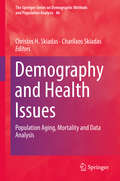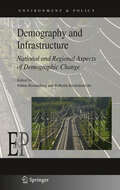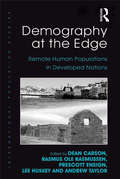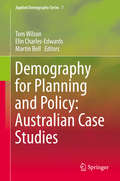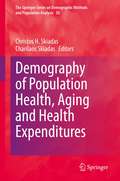- Table View
- List View
Demographic Analysis: Projections on Natality, Fertility and Replacement
by Roland PressatPopulation control requires that the birth rate equal to the death rate. If it is too low population will decline; if it is too high, population will increase. If either condition persists long enough the population will diminish towards zero or increase towards infinity. Fortunately, the birth trajectory does not have to be set once and for all, but can be adjusted within limits. Since birth and death rates determine whether we are heading for population extinction or explosion, they are well designated "vital statistics." Their understanding and use are a central theme of demographic analysis."Demographic Analysis" presents those techniques that are often called for in the study of demographic problems. Such techniques permit researchers to fill the gap between the large amounts of data made available by censuses and the theoretical and practical questions that need to be answered; the techniques of this book effectively bring the data into confrontation with the problems. In his treatment of population projection, Pressat applies methods developed in earlier sections for mortality arid fertility. The emphasis is on population projection and accords with its usefulness in demographic analysis. The meaning of a demographic rate or trend is brought out by seeing to what condition it would lead if continued. No assumption is made that the concrete future will follow either path.The substance of the book is devoted to the main themes of mortality and fertility. Underlying these as well as nearly every other kind of data with which the demographer deals is the problem of location in time - the relation of vital events to the calendar, and also to the age of the persons undergoing them. Pressat's detailed attention to this problem forms a solid basis for how current methodology accounts of demographic changes.
Demographic Angst: Cultural Narratives and American Films of the 1950s
by Alan NadelProlific literature, both popular and scholarly, depicts America in the period of the High Cold War as being obsessed with normality, implicitly figuring the postwar period as a return to the way of life that had been put on hold, first by the Great Depression and then by Pearl Harbor. Demographic Angst argues that mandated normativity—as a political agenda and a social ethic—precluded explicit expression of the anxiety produced by America’s radically reconfigured postwar population. Alan Nadel explores influential non-fiction books, magazine articles, and public documents in conjunction with films such as Singin’ in the Rain, On the Waterfront, Sunset Boulevard, and Sayonara, to examine how these films worked through fresh anxieties that emerged during the 1950s.
Demographic Assessment Techniques in Complex Humanitarian Emergencies: SUMMARY OF A WORKSHOP
by Holly ReedA summary of the Demographic Assessment Techniques in Complex Humanitarian Emergencies
Demographic Change and Economic Growth: Simulations on Growth Models
by Lars WeberIn this book the author investigates the impact of demographic change on economic growth. As a result of the current financial crisis, a new view on economics has been demanded by various scientists. The author provides such a new view on economic growth, using a methodology of system dynamics. By applying this method, the author focuses on characteristics of complex systems and analyzes aging and shrinking processes, and not only positive growth. Delays and feedback processes are also considered. This leads to deeper and revealing insights into economic behavior. In doing so, a new semi-endogenous growth model is developed by introducing a specific and detailed population sector (demographic growth model). The book shows and analyzes the behavior of such a model and tests several policy scenarios in a transfer chapter to apply the new theoretical approach on real world problems. The major results are summarized in 15 principles of demographic growth.
Demographic Change and Housing Wealth:
by Kees Dol John Doling Nick Horsewood Hanna Szemzo József Hegedüs Nóra Teller Richard Ronald Marja Elsinga Janneke ToussaintAcross the EU, populations are shrinking and ageing. An increasing burden is being placed on a smaller working population to generate the taxes required for pensions and care costs. Welfare states are weakening in many countries and across Europe, households are being increasingly expected to plan for their retirement and future care needs within this risky environment. At the same time, the proportion of people buying their own home in most countries has risen, so that some two-thirds of European households now own their homes. Housing equity now considerably exceeds total European GDP. This book discusses questions like: to what extent might home ownership provide a potential cure for some of the consequences of ageing populations by realizing housing equity in order to meet the consumption needs of older people? What does this mean for patterns of inheritance and longer-term inequalities across Europe? And to what extent are governments banking on their citizens utilising their housing wealth now and in the future?
Demographic Change in Australia's Rural Landscapes
by Rosemary Black Gary W. Luck Digby RaceThroughout history, humans have lived primarily in rural landscapes. In 2008, for the first time, the global population became predominantly urban. While much research has focussed on the impacts of increasing urbanisation, we have very little knowledge of the implications of these changes for rural landscapes. Global trends suggest populations in rural landscapes are, relatively speaking, in decline. Yet this broad trend is too simplistic and can be very misleading for researchers, land managers and policy makers. This generalisation often masks a much more complex and dynamic process of demographic change, with some rural areas increasing in popularity and experiencing new environmental pressures. The patterns of change can be broadly characterised in two ways: population decline and dissolving rural communities; and amenity-led in-migration (or counter-urbanisation) - a trend identified in developed regions such as North America and Australia. Both of these patterns have substantial implications for the management and sustainability of rural landscapes and communities. This book examines broad and local-scale patterns of demographic change in rural landscapes, identifying some of the drivers of these changes using local case studies, and outlining the implications of changes for society and the environment. The book adopts an interdisciplinary approach by explicitly linking demographic change with environmental, land-use, social and economic factors. The book will provide a useful resource for researchers and graduate students interested in urban development, sustainability science, landscape studies and demographic change, as well as environmental management, human and physical geography and rural sociology.
Demographic Dividends: Emerging Challenges and Policy Implications
by Roberta Pace Roberto Ham-ChandeThis book examines potential economic opportunities that countries can experience when fertility rates fall and the average life expectancy of the working age population increases. It presents detailed demographic and economic analysis of middle-income countries throughout the world in order to show how these countries can take advantage of this demographic bonus. The book first traces the common link between policies that contribute to fertility transition as well as create the right kind of environment for reaping the benefit of demographic dividend. Next, it explores different countries and regions who are at different levels of development. It assesses the long term impact of gender equality on economic growth and development in Latin America; describes the life-cycle saving patterns of Mexican households; and examines demographic determinants of economic growth in BRICS. The book also offers demographic and economic analysis of the Mediterranean area, Sub-Saharan Africa, and New Zealand. The comparison between the different territorial contexts allow for the identification of three typologies of demographic dividend: the first dividend, when the working population grows faster than total population, the second dividend, as active generations get older and invest their savings in the production system of their country, and the third dividend, based on the coexistence of two populations age structure strongly contrasting. Overall, this book argues for the need to capitalize on the opportunities that come from the demographic dividend by investing heavily in education programs, training programs for the population working age, health programs, the creation of health insurance systems as well as programs to reduce or increase fertility levels.
Demographic Dynamics and Development
by Yves CharbitOne of the major challenges facing the world today is the interaction between demographic change and development. Demographic Dynamics and Development reviews the dominant demographic theory, demographic transition, and then presents a thorough investigation covering aging, fertility, contraception, nuptiality, mortality and migration, which are all aspects that drive these changes. Each chapter combines the latest empirical data with theoretical reflections on the implications for development.This book thus offers an overview of worldwide demographic data, studied with a view towards development. In doing so, it provides researchers and specialists with clear information through in-depth case studies, focusing on a country, a region or a particularly important scientific sub-theme.
Demographic Engineering: Population Strategies In Ethnic Conflict (International Population Studies)
by Paul MorlandDemography has always mattered in conflict, but with conflict increasingly of an inter-ethnic nature, with sharper demographic differences between ethnic groups and with the spread of democracy, numbers count in conflict now more than ever. This book argues for and develops a framework for demographic engineering which provides a fresh perspective for looking at political events in countries where ethnicity matters. It asks how policies have been framed and implemented to change the demography of ethnic groups on the ground in their own interests. It also examines how successful these policies have been, focusing on the cases of Sri Lanka, Israel/Palestine, Northern Ireland and the USA. Often these policies are hidden but author Paul Morland teases them out with skill both from the statistics and documentary records and through conversations with participants. Offering a new way of thinking about demographic engineering (’hard demography’ versus ’soft demography’) and how ethnic groups in conflict deploy demographic strategies, this book will have a broad appeal to demographers, geographers and political scientists.
Demographic Gaps in American Political Behavior
by Patrick FisherDemographic Gaps in American Political Behavior examines the political behavior of various groups in the United States in an effort to demonstrate how demographic backgrounds and socialization affect political behavior. Media coverage has disproportionately focused on the red state versus blue state divide, leaving the impression that American political behavior is determined solely by place of residence. This, however, ignores the numerous other political divides that exist in the United States today. In order to better conceptualize the landscape of American political behavior, Patrick Fisher analyzes the political gaps in six different demographics--income, religion, gender, race, age, and geography--and examines the effect these political gaps have on public opinion, policy, and party positioning. Written in an accessible fashion, Demographic Gaps in American Political Behavior uses contemporary examples and data from the 2008 and 2012 elections to help readers understand how and why demographic background has the potential to greatly influence political opinions and behavior.
Demographic Patterns in Developed Societies (Routledge Library Editions: Demography #7)
by R. W. HiornsOriginally published in 1980, this volume reviews the demographic patterns of fertility, marriage and mortality with reference to developed societies in the 19th and 20th centuries in Western Europe and North America. New (at the time of publication) data and methodology are considered and discussed, while maintaining the historical perspective.
Demographic Shifts and Digital Innovation in the Public Sector (SpringerBriefs in Entrepreneurship and Innovation)
by Mehmet Akif Demircioglu Manuel Di Loreto Kohei SuzukiThis book examines the impact of demographic decline on digital innovation in the public sector. Utilizing data from Italian municipalities, it provides quantitative and qualitative analyses to reveal the negative impact of demographic decline on digital innovation, which presents a unique challenge for policymakers seeking to foster technological advances in a shrinking, ageing society. This book also investigates the roles of macro-level social, economic, demographic, and administrative factors in the innovation of public organizations. By highlighting these broader demographic dynamics, this book challenges existing theories of public sector innovation, urging greater attention to slow-moving external factors as critical drivers of long-term innovation strategies.
Demographic Transition and Social Policy in Latin America and the Caribbean
by Daniel CotlearLatin America and the Caribbean will soon face the challenges of an aging population. This process, which took over a century in the rich world, will occur in two or three decades in the developing world; seven of the 25 countries that will age more rapidly are in LAC. Population aging will pose challenges and offer opportunities. This book explores three sets of issues. First is a group of issues related to the support of the aging and poverty in the life cycle. This covers questions of work and retirement, income and wealth, and living arrangements and intergenerational transfers. It also explores the relation between the life cycle and poverty. Second is the question of the health transition. How does the demographic transition impact the health status of the population and the demand for health care? And how advanced is the health transition in LAC? Third is an understanding of the fiscal pressures that are likely to accompany population aging and to disentangle the role of demography from the role of policy in that process. This book provides an introduction to the concepts and techniques at the intersection of demography and economics. It summarizes the policy debate about potential reforms needed to make population aging an opportunity for development.
Demographic Transition, Labour Markets and Regional Resilience
by Cristina Martinez Tamara Weyman Jouke Van DijkThis book discusses the question of how a regional economy can develop under the influence of an ageing and declining population, and how regional development policies can help make labor markets more resilient and more inclusive. As the greatest impacts of demographic change and policy and fiscal challenges can be observed at the local level, examples from European, North American and Asian regions are combined to present a comprehensive, global range of strategic solutions from different policy contexts. The book shows how institutions, organizations and communities can enhance their pathways for sustainable development through the intelligent management of their demographic transition, and offers a synthesis of valuable lessons and strategies.
Demographic and Family Transition in Southeast Asia
by Wei-Jun Jean YeungThis open access book presents the trends and patterns of demographic and family changes from all eleven countries in the region for the past 50 years. The rich data are coupled with historical, cultural and policy background to facilitate an understanding of the changes that families in Southeast Asia have been going through. The book is structured into two parts. Part A includes three segments preceded by a briefing on Southeast Asia. The first segment focuses on marital and partnership status in the region, particularly marriage rates, age at marriage, incidence of singlehood, cohabitation, and divorce. The second segment focuses on fertility indicators such as fertility rates (total, age-specific, adolescent), age at childbearing, and childlessness. The third presents information on household structures in the region by examining household sizes, and incidence of one-person households, single-parent families, as well as extended and composite households. Part B presents indicators of children and youth’s well-being.
Demographics Unravelled: How Demographics Affect and Influence Every Aspect of Economics, Finance and Policy
by Amlan RoyDiscover what demographics can tell us about the economy, markets, and the future In Demographics Unravelled, renowned Macro-Demographics expert Amlan Roy delivers an insightful and timely exploration of the impact that “people characteristics” have on national economies. Considering factors like gender, race, migrant status, family background, and education, the author delves deeply into a subject that drives market behavior and economic variables, including growth, debt, inflation, employment, and productivity. These have national and international policy implications. In this one-of-a-kind book, you’ll discover: Why the study of demographics is the hidden key to understanding economic growth, asset prices, and capital flows How to use detailed demographics to forecast future scenarios in economics, socioeconomics, geopolitics, and the environment The short-, medium-, and long-term effects of consumer and worker behavior How understanding demographics is key to understanding health, pensions, migration, sustainability and social policies. It is intimately linked to the Sustainable Development Goals of the UN—Gender, Climate, Poverty and Inequality Perfect for institutional investors, insurance professionals, economists, and business leaders, Demographics Unravelled will also earn a place in the libraries of academics and students studying a variety of economic disciplines and seeking a one-stop and in-depth discussion of demographics-driven macroeconomic effects.
Demographics and Innovation in the Asia-Pacific
by Karen Eggleston, Joon-Shik Park, and Gi-Wook ShinDemographic transition, along with the economic and geopolitical re-emergence of Asia, are two of the largest forces shaping the twenty-first century, but little is known about the implications for innovation. The countries of East Asia have some of the oldest age structures on the planet: between now and 2050, the population that is age 65 and older will increase to more than one in four Chinese, and to more than one in three Japanese and Koreans. Other economies with younger populations, like India, face the challenge of fully harnessing the "demographic dividend" from large cohorts in the working ages. This book delves into how such demographic changes shape the supply of innovation and the demand for specific kinds of innovation in the Asia-Pacific. Social scientists from Asia and the United States offer multidisciplinary perspectives from economics, demography, political science, sociology, and public policy; topics range from the macroeconomic effects of population age structure, to the microeconomics of technology and the labor force, to the broader implications for human well-being. Contributors analyze how demography shapes productivity and the labor supply of older workers, as well as explore the aging population as consumers of technologies and drivers of innovations to meet their own needs, as well as the political economy of spatial development, agglomeration economies, urban-rural contrasts, and differential geographies of aging.
Demographics and the Demand for Higher Education
by Nathan D. GraweThe decisions we make in the next five years are critical in determining whether colleges thrive or flounder.2017 National Student Clearinghouse Research Center Award for Outstanding AACRAO SEM Research PresentationHigher education faces a looming demographic storm. Decades-long patterns in fertility, migration, and immigration persistently nudge the country toward the Hispanic Southwest. As a result, the Northeast and Midwest—traditional higher education strongholds—expect to lose 5 percent of their college-aged populations between now and the mid-2020s. Furthermore, and in response to the Great Recession, child-bearing has plummeted. In 2026, when the front edge of this birth dearth reaches college campuses, the number of college-aged students will drop almost 15 percent in just 5 years.In Demographics and the Demand for Higher Education, Nathan D. Grawe has developed the Higher Education Demand Index (HEDI), which relies on data from the 2002 Education Longitudinal Study (ELS) to estimate the probability of college-going using basic demographic variables. Analyzing demand forecasts by institution type and rank while disaggregating by demographic groups, Grawe provides separate forecasts for two-year colleges, elite institutions, and everything in between. The future demand for college attendance, he argues, depends critically on institution type. While many schools face painful contractions, for example, demand for elite schools is expected to grow by more than 15 percent in future years.Essential for administrators and trustees who are responsible for recruitment, admissions, student support, tenure practices, facilities construction, and strategic planning, this book is a practical guide for navigating coming enrollment challenges.
Demography and Degeneration
by Richard A. SolowayRichard Soloway offers a compelling and authoritative study of the relationship of the eugenics movement to the dramatic decline in the birthrate and family size in twentieth-century Britain. Working in a tradition of hereditarian determinism which held fast to the premise that "like tends to beget like," eugenicists developed and promoted a theory of biosocial engineering through selective reproduction. Soloway shows that the appeal of eugenics to the middle and upper classes of British society was closely linked to recurring concerns about the relentless drop in fertility and the rapid spread of birth control practices from the 1870s to World War II.Demography and Degeneration considers how differing scientific and pseudoscientific theories of biological inheritance became popularized and enmeshed in the prolonged, often contentious national debate about "race suicide" and "the dwindling family." Demographic statistics demonstrated that birthrates were declining among the better-educated, most successful classes while they remained high for the poorest, least-educated portion of the population. For many people steeped in the ideas of social Darwinism, eugenicist theories made this decline all the more alarming: they feared that falling birthrates among the "better" classes signfied a racial decline and degeneration that might prevent Britain from successfully negotiating the myriad competive challenges facing the nation in the twentieth century.Although the organized eugenics movement remained small and elitist throughout most of its history, this study demonstrates how pervasive eugenic assumptions were in the middle and upper reaches of British society, at least until World War II. It also traces the important role of eugenics in the emergence of the modern family planning movement and the formulation of population policies in the interwar years.
Demography and Health Issues: Population Aging, Mortality And Data Analysis (The\springer Series On Demographic Methods And Population Analysis Ser. #46)
by Christos H. Skiadas Charilaos SkiadasThis book provides new theories, applications and quantitative methods in demography, population studies and statistics. It presents and applies data analysis, statistics and stochastic modeling techniques focusing on demography, population aging, mortality and health sciences. The book describes diverse stochastic processes as well as Markov and semi-Markov models in demography and population studies, along with chapters on statistical models and methods in biostatistics and epidemiology. As such the book will be a valuable source to demographers, health scientists, statisticians, economists and sociologists.
Demography and Infrastructure
by Wilhelm Kuckshinrichs Tobias KronenbergPopulation ageing has been going on for many decades, but population shrinking is a rather new phenomenon. The population of Germany, as in many other countries, has passed a plateau and is currently shrinking. Demographic change is a challenge for infrastructure planning due to the longevity of infrastructure capital and the need to match supply and demand in order to ensure cost-efficiency. This book summarises the findings of the INFRADEM project team, a multidisciplinary research group that worked together to estimate the effects of demographic change on infrastructure demand. Economists, engineers and geographers present studies from top-down and bottom-up perspectives, focusing on Germany and two selected regions: Hamburg and Mecklenburg-Western Pomerania. The contributors employed a broad range of methods, including an overlapping-generations model for Germany, regional input-output models, an energy systems model, and a spatial model of the transportation infrastructure.
Demography and the Graeco-Roman World
by April Pudsey Claire HolleranThrough a series of case studies this book demonstrates the wide-ranging impact of demographic dynamics on social, economic and political structures in the Graeco-Roman world. The individual case studies focus on fertility, mortality and migration and the roles they played in various aspects of ancient life. These studies - drawn from a range of populations in Athens and Attica, Rome and Italy, and Graeco-Roman Egypt - illustrate how new insights can be gained by applying demographic methods to familiar themes in ancient history. Methodological issues are addressed in a clear, straightforward manner with no assumption of prior technical knowledge, ensuring that the book is accessible to readers with no training in demography. The book marks an important step forward in ancient historical demography, affirming both the centrality of population studies in ancient history and the contribution that antiquity can make to population history in general.
Demography at the Edge: Remote Human Populations in Developed Nations (International Population Studies)
by Rasmus Ole Rasmussen Prescott Ensign Lee HuskeyAddressing the methodological and topical challenges facing demographers working in remote regions, this book compares and contrasts the research, methods and models, and policy applications from peripheral regions in developed nations. With the emphasis on human populations as dynamic, adaptive, evolving systems, it explores how populations respond in different ways to changing environmental, cultural and economic conditions and how effectively they manage these change processes. Theoretical understandings and policy issues arising from demographic modelling are tackled including: competition for skilled workers; urbanisation and ruralisation; population ageing; the impacts of climate change; the life outcomes of Indigenous peoples; globalisation and international migration. Based on a strong theoretical framework around issues of heterogeneity, generational change, temporariness and the relative strength of internal and external ties, Demography at the Edge provides a common set of approaches and issues that benefit both researchers and practitioners.
Demography for Planning and Policy: Australian Case Studies
by Tom Wilson Elin Charles-Edwards Martin BellThis edited collection shows how demographic analysis plays a pivotal role in planning, policy and funding decisions in Australia. Drawing on the latest demographic data and methods, these case studies in applied demography demonstrate that population dynamics underpin the full spectrum of contemporary social, economic and political issues. The contributors harness a range of demographic statistics and develop innovative techniques demonstrating how population dynamics influence issues such as electoral representation, the distribution of government funding, metropolitan and local planning, the provision of aged housing, rural depopulation, coastal growth, ethnic diversity and the well-being of Australia's Indigenous community. Moving beyond simple statistics, the case studies show that demographic methods and models offer crucial insights into contemporary problems and provide essential perspectives to aid efficiency, equity in public policy and private sector planning. Together the volume represents essential reading for students across the social sciences as for policy makers in government and private industry.
Demography of Population Health, Aging and Health Expenditures (The Springer Series on Demographic Methods and Population Analysis #50)
by Christos H. Skiadas Charilaos SkiadasThis book provides theoretical and applied material for estimating vital parts of demography and health issues including the healthy aging process along with calculating the healthy life years lost to disability. It further includes the appropriate methodology for the optimum health expenditure allocation. Through providing data analysis, statistical and stochastic methodology, probability approach and important applications, the book explores topics such as aging and mortality, birth-death processes, self-perceived age, life-time and survival as well as pension and labor-force. By providing a methodological approach to health problems in demography and society including and quantifying important parameters, this book is a valuable guide for researchers, theoreticians and practitioners from various disciplines.
